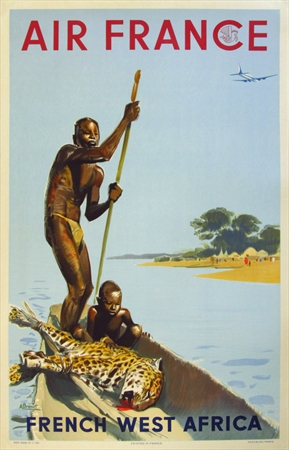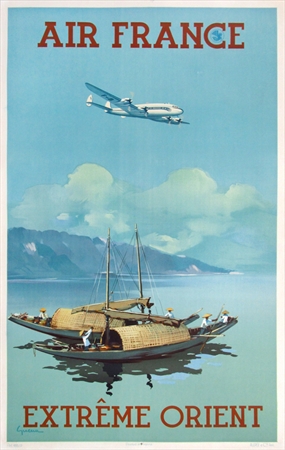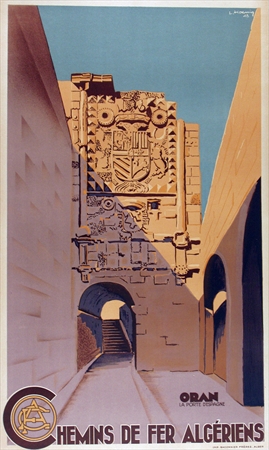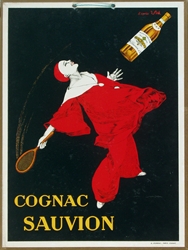How Much Cover is Too Much, or Too Little? The French bathing suit controversy as represented in original source material
September 1, 2016 § Leave a comment
French beaches, or more accurately, the mayors of some French beach towns, have made headlines in recent weeks for their, so called, “Burkini Ban.” Many, including the New York Times and CNN, have commented on everything from the socio-political nature of the decision to it’s oddly hypocritical tone in the face of our more modern and multicultural western identity.
Posters, primary source documentation that speaks volumes to the ideals and cultural customs of their time, are snapshots into the past. The posters below highlight the fluid nature of French and Italian beach fashion across the decades.
This poster shows women, and men, in an array of beach wear. You can spot everything from bikinis and swim trunks to the couple in a high necked, full length gown and suit.
The swimsuit worn by the sunbather in this poster would seem harmless to many today. However, it was still considered revealing to many during that time.
This swimwear advertisement, from the same time period as the one above, leaves little to the imagination. Showcasing a naked woman in order to sell products was nothing new by this era but using this as an advertisement for beach wear, then policing what women wear at the beach shows the contradictory nature of the time. It also highlights how little has changed since then.
This poster advertises 150 years for the Baths of Rimini. Interestingly, Rimini is the same beach town mentioned in the New York Times article that inspired this piece. It begs the question; how will women’s self expression and personal representation be viewed by the world on the Rimini bath’s 170th anniversary?
***
This post was written by Susannah Starr, Summer Intern and Edited by Elizabeth Norris, Vintage European Posters
Established 1997
Member IVPDA
Our Shop: 2201 Fourth Street, Berkeley Corner of Allston Way
Summer Hours Tuesday- Thursday 11-5
and select weekends
Also available by appointment
Please call 510 843 2201 or email vintage posters@vepca.com to confirm hours.
Visit our collection on the web at vepca.com
Air France: French West Africa and Extrême Orient
August 14, 2016 § Leave a comment
After World War Two commercial air travel was, for the first time accessible to the public. Wartime technological advancements including radar and improvements in engineering led to faster, safer, and larger planes. An adventurous traveler could now leave their continent and in less than a day find themselves on the other side of the globe. Travel posters, always a tool of mass communication, showed exotic destinations as a means of announcing, “The world is now open to all.” Air France, one of the preeminent airlines both before and after WWII, employed the poster expertly. Their routes traced a history of commerce and many were carved out through colonialism. It is interesting to look at Air France’s choices of which destinations to promote to tourists in their advertising posters and also to examine the images used to evoke adventure, exoticism and ownership.
Although the war afforded advancements in technology and global economics, other institutions, like colonialism, persisted. Many European countries held stake in colonies thousands of miles apart. The British Empire’s holdings in India, the Middle East, and East Africa are often at the forefront of people’s minds, however, France and even smaller nations like Belgium and Portugal were key colonial players. France held power in North and West Africa as well as Vietnam, Laos, Cambodia, and the Caribbean.
***
Of the Allied powers, the French suffered particular hardship during WWII. As a Nazi occupied nation and one situated on the front lines, France’s infrastructure and economy were decimated by the end of war. Despite this, companies like Air France thrived in the new postwar environment. Flights around France, Europe, and the French colonies in Africa, Asia, and the Caribbean became increasingly popular. France’s colonial presences in West Africa and the Far East or L’Extrême Orient, especially Vietnam, made travel to these locations seem exotic yet possible. Posters, like the ones below, were created to market these destinations. The posters themselves, very similar in subject matter, speak to the ethos of the time.

The West Africa poster was created in 1949 by Albert Brenet and shows two young men in a West African pirogue with their prey. This striking image makes references to the exotic bounty of the colony and would have grabbed the attention of any passer by.

Extrême Orient by Vincent Guerra, was printed in in 1950 and features a beautiful bay and mountain scene with fishermen in their woven topped junks. The prominence of the plane shows France’s ownership of this scene as if to say “It’s ours- come explore it.” Both of these images seem to symbolize a rural, bucolic lifestyle that wasn’t quite the reality (pg. 130 Air France, https://www.scribd.com/document/54130846/The-Junk-Blue-Book). The Vietnam of the 1950s was fully embroiled in a war for its independence, first from the Japanese, then the French, culminating in the Vietnam War.

West Africa suffered similar hardships at the hand of its colonial rulers. While embroiled in bureaucratic struggles for recognition by the French Government, the native peoples of these West African nations, (Sénégal, Mali, Côte D’Ivoire, Burkina Faso, Mauritania, French Guinea, Benin, and Niger) were treated as subjects not citizens. Independence came in March of 1962 after the bloody Algerian War.
Today the colonial references on these posters are so obvious as to be almost embarrassing to the Western viewer. But they are an indelible record of the prevailing attitudes of the time period, as are all advertising posters. It’s important that they be preserved so that their messages are not forgotten.
This post was written by Susannah Starr, Summer Intern and Elizabeth Norris, Proprietor of Vintage European Posters.
Established 1997
Member IVPDA
Our Shop: 2201 Fourth Street, Berkeley Corner of Allston Way
Summer Hours Tuesday- Thursday 11-5
and select weekends
Also available by appointment
Please call 510 843 2201 or email vintageposters@vepca.com to confirm hours.
Visit our collection on the web at vepca.com
Cognac Sauvion
July 30, 2016 § Leave a comment

by J. Stall, Printed 1925 in France, Original Lithograph on cardboard
A playful poster featuring a Pierrot popping out from a solid black background. This example was printed on cardboard or ‘carton’ as it is called in France. The piece has a string looped through grommets at the top. These window cards were designed to hang in store windows or directly on cash registers as ‘point of purchase’ advertising.
This post was written by Elizabeth Norris, owner of Vintage European Posters
Vintage European Posters is a Berkeley based dealer of
Original French & American Advertising Posters.
Our Showroom is located at 2201 Fourth Street in Berkeley, corner of Allston Way.
Summer of 2016 we are open on Tuesdays, Wednesdays and Thursdays 11-5
and select weekends. Please call ahead to confirm our hours.
Established in 1997, VEP now exhibits at 12 shows per year in California including
Dwell on Design, Palm Springs Modernism, and the Healdsburg Antiques on the Plaza.
Our website www.vepca.com is always up to date.
La Bouillie Soleil
July 28, 2016 § Leave a comment

Anonymous, Printed in France circa 1930 Original Stone Lithograph
This clever piece was created in the Art Deco period and features the high contrast colors which characterizes art deco graphic style. This poster is aimed at the small vintner and advertises a product “La Bouillie Soleil” which is described as a pulp or mash – and so probably includes both fertilizer and sulfur, and perhaps an insecticide. The tag line ‘the savior of your harvest.’ Is a reference to phylloxera, an aphid borne disease which had wiped out French vineyards in the mid 19th century. These products were essential in the reestablishment of French vineyards. The cards are meant to symbolize luck and therefore suggest that the user is a lucky farmer or wine maker.
This post was written by Elizabeth Norris, owner of Vintage European Posters
Vintage European Posters is a Berkeley based dealer of
Original French & American Advertising Posters.
Our Showroom is located at 2201 Fourth Street in Berkeley, corner of Allston Way.
Summer of 2016 we are open on Tuesdays, Wednesdays and Thursdays 11-5
and select weekends. Please call ahead to confirm our hours.
Established in 1997, VEP now exhibits at 12 shows per year in California including
Dwell on Design, Palm Springs Modernism, and the Healdsburg Antiques on the Plaza.
Our website www.vepca.com is always up to date.
World War One and Trench Warfare; the Centennial of The Battles of Frontiers
August 7, 2014 § 1 Comment
August 7th: One hundred years ago today, The Battle of Frontiers began between France and Germany, characterized by the trench warfare and stalemate of World War I.
The Battles of the Frontiers was a series of battles held on the Western Front during WWI, beginning with the Battle of Liège on August 4th, 1914. These battles kicked off the characteristic stalemate and deadly trench warfare of the First World War. The German armies followed the meticulously drawn up Schlieffen Plan which called for a quick defeat of French forces in the West just in time to move to the East to defeat Russian forces. The great miscalculation was the amount of time it would take to defeat France; Germany also underestimated how long it would take Russia to mobilize their forces (Russia took a mere 10 days to mobilize rather than six weeks). As a result, Germany was forced to diffuse their armies and fight two fronts at the same time. Germany’s failure in a quick defeat against France resulted in the building of trenches, creating a war of attrition where attacks with improved weaponry caused an immense loss of life.
In this French poster calling for French citizens to purchase war bonds, a winged women symbolizing Victory with the French flag flies over a sea of dead German soldiers. Following the winged figure is a sea of soldiers carrying the numerous flags of the Allies.
To see more posters like the one pictured above, check out our upcoming show titled “A Call to Action; Posters of the First World War” which includes over 100 original World War I propaganda posters. The Show will run from September 13- September 23rd at our gallery at 2201 Fourth Street, in Berkeley, CA.
This post was written by Nicole Garson, Intern, UCB class of 2016 and Elizabeth Norris, Proprietor of Vintage European Posters
Our Shop is Open Tuesdays-Thursdays from 11-5 and select weekends.
2201 Fourth Street, Berkeley Corner of Allston Way
Please call 510 843 2201 or email vintage posters@vepca.com to confirm hours.
Visit our collection on the web at vepca.com





